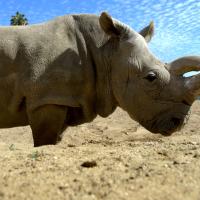Scientists don’t need a 100-million-year-old mosquito that’s been perfectly preserved in amber to get their nitrile gloves on dinosaur DNA; it’s alive and well, clucking around inside every chicken on the planet.
It’s true that dinosaurs went extinct, but they never really left us. Their descendants, modern day birds, are still thriving with prehistoric dinosaur DNA in their genetic history. Scientists are now able to roll back the mutations that have occured over eons to, in a sense, “recreate” dinosaurs.
So… Are Birds Dinosaurs?
No; birds aren’t dinosaurs, but they’re the closest thing we’ve got. At the end of the Cretaceous period roughly 66 million years ago, an asteroid wiped out 75% of life on Earth. Among the survivors were a small group of ground-dwelling birds: the ancient ancestors of modern day chickens.
The birds we know and love today, wattles and all, haven’t undergone many evolutionary changes since then. Although crocodiles, as a species, are older than chickens, they existed alongside the dinosaurs like neighbors rather than family.
Chickens are actually direct – albeit petite – descendents. As a result, chicken DNA is surprisingly most closely related to dinosaur DNA.
Using Birds to Study Dinosaur DNA
Working specifically with chickens, Arkhat Abzhanov, genetics researcher at Imperial College London, and Bhart-Anjan Bhullar, who’s involved in similar research at Yale, are finding novel ways to study dinosaurs and evolution.
Abzhanov compared chickens to reptiles and other birds that have undergone major evolutionary transformations, looking specifically at the DNA and skeletal structure of skulls, beaks, and snouts.
Studying these features in detail makes it possible to ask questions like, “What sort of genetic mutations are responsible for the emergence of a beak from a reptilian snout?”.
To model these physiological observations, Abzhanov uses a morphological space, which is a conceptual tool that applies analytics to recording and predicting evolutionary changes in a 3-dimensional space.
With this model, he’s able to use observable data to demonstrate and theorize how a species changes over time, or throughout the course of development from juvenile to adult – even when there’s a gap in the fossil record.
Morphospace modeling combined with a thorough analysis of genetics enabled Abzhanov to begin to understand what sort of genetic mutations lead to the observed changes in anatomy. His research focused specifically on the genetics of the bones that make a snout or beak.
After analyzing data from many species, he was able to identify the beak gene. By blocking how the specific gene expressed, his lab produced a chicken embryo that developed a snout instead of a beak – exactly as the morphospace model had predicted.
Abzhanov’s goal is to understand the molecular basis for a major transition in evolution. It’s not to create chickens with dinosaur snouts, so the genetically modified chicken embryos were never hatched.
With additional research, a chicken’s entire face could be gradually reverted to its ancestral condition. There are other scientists currently performing similar research but looking at tails, wings, feathers, and feet, to try to understand how genes change each specific characteristic.
Do We Really Want to Bring T-Rex Back?
It’d be much simpler to answer all our questions about prehistoric life by observing it in the flesh, but we’re all too familiar with the violent success that was Michael Crichton’s Jurassic Park. Without even mentioning the ethical implications of cloning an extinct species, there are other reasons it’s probably not the best idea.
It’s impossible to predict all the potential consequences of raising an extinct species from the dead. Doing so could have a profoundly detrimental effect on modern species, or open up new pathways for the evolution of dangerous zoonotic diseases.
Thankfully, we can all sleep soundly because science is still a long way from even approaching the ability to hatch a T-Rex from a chicken egg. Plus, cloning dinosaurs isn’t the purpose of Abzhanov’s research.
Dinosaur DNA is still here; it’s been passed on by the very process of life itself. Abzhanov’s research is about appreciating the incredible legacy we all carry inside ourselves. Ultimately, the knowledge gained from this research could help scientists crack the code for all DNA.
People, animals, and even plants, all hold billions of years of evolution in our cells, veritable tomes of genetic history. By seeking to understand the incredible complexity of all this, we can begin to develop new technologies.
The knowledge gained from this research could help scientists crack the code for all DNA.
Practical applications of the information gained through researching genetic evolution could include engineering better livestock and crops, treating congenital conditions, preventing genetic diseases, and curing other developmental disorders.
With more research like Abzhanov’s, scientists might eventually be able to map out precisely how DNA produces the sophisticated biology within us. If genetic science reaches this level of transparency, the possibilities for modification and creation will only be limited by our imaginations.
For more interesting news about the people and ideas that are changing our world, subscribe to Freethink.


